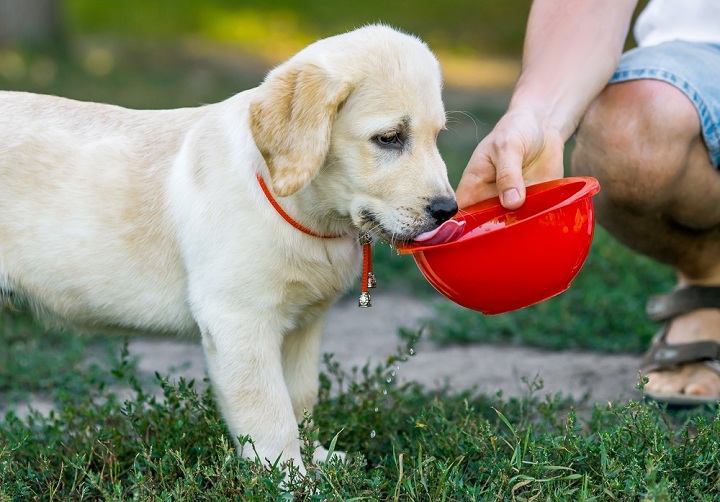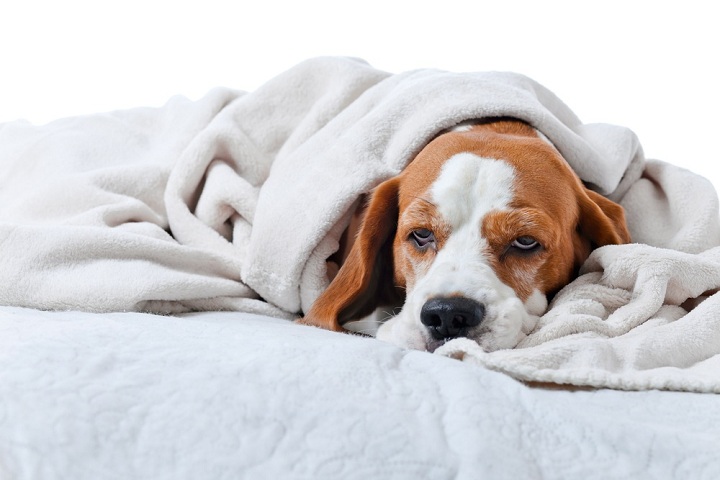How to rehydrate your sick dog

Just like all living things like humans and plants, animals like dogs depend on enough fluid intake for optimal health. In fact, water makes up to 80 percent of a dog’s body. But all those fluids in a dog’s body would get depleted if she is sick. When fluid levels in a dog’s body drop to less than the normal, then the canine is suffering from dehydration.
There are several reasons why a dog is dehydrated. Just like in cats, diarrhea can cause dogs to be dehydrated. Vomiting excessively due to sickness is another possible reason.
Whatever the reason maybe, it’s very likely that a dehydrated dog is sick. If your dog is not feeling well, how would you rehydrate her?
Signs of dehydration in dogs
Before we discuss how to rehydrate your sick dog, let’s first identify the signs of dehydration in canines.
There are several tell-tale signs that your dog is suffering from dehydration. Perhaps the most obvious is the reduced elasticity of her skin. This isn’t surprising because water keeps a canine’s skin healthy and elastic. But the skin of a dehydrated dog won’t spring back normally when you lift it.
Of course, older dogs don’t have elastic skin. The same goes for obese dogs, so keep that in mind when checking if your dog is dehydrated.
Another indicator that a dog is suffering from dehydration is when her gums look dry and sticky. The color of the gum may also tell if the canine is dehydrated. Usually, a dog who’s dehydrated has pale pink or whitish gums.
You should also check the eyes of your dog. Canines that are well hydrated have bright, full eyes. Does your dog have eyes that look sunken in? If it does, it is very likely that she is dehydrated.
Dehydrated dogs are also lethargic and depressed. An increase in heart rate can also be indicative of dehydration in dogs. You can measure your dog’s heart rate by putting your fingers on her femoral artery then counting the beats for 15 seconds and multiplying it by 4. If the number exceeds 160 beats per minute, then your dog has an increased heart rate.

How to rehydrate a sick dog
Trying to rehydrate a sick dog is more difficult than it appears. You can give her all the water in the world, but if she vomits every time she drinks, then your efforts would prove futile. Of course, a sick dog may also refuse to drink at all.
I would suggest that you wait until your pet has stopped vomiting before offering her some drinks. Two hours of not vomiting should be enough time for the dog’s stomach to settle down.
After the two-hour period has lapsed, attempt to give her water slowly and gradually. One to two tablespoons of water every 15 minutes should be a good start. If she still vomits the water that you gave her, try to give another tablespoon or two of ice cubes after a couple of hours.
Let’s say that the dog didn’t vomit the water that you gave her. Your next goal would be to replenish the lost electrolytes in her body. Give her clear liquids like a mixture of 50 percent water and chicken broth sans onion or garlic. You can also give her equal parts water and Pedialyte.
You should aim to give your pet a cup of fluids for every 40 pounds of body weight in the next two to three hours. You ought to increase the amount of water in the next 12 hours.
If the dog doesn’t vomit in the next 12 to 24 hours, you can start offering her some bland food diet. I usually add some water to bland food so that it would be more watery and provide further. You can give half a cup of bland food for every 50 pounds of body weight in the next one to two hours.
If your dog feels better, you can try to feed your pet a little bit this all-in-one-bowl homemade dog food which is a combination of beef, chicken, turkey and a lot of water stew. She will be well soon.
If she vomits again after eating, don’t fret— you can try giving her bland food (albeit in lower quantity) in the next hour. But if she didn’t vomit, then look to increase the amount of food over the next day or two.
Then slowly add the regular kibble of your dog to the bland diet for the next 2-3 days until the kibble completely replaces the bland diet.
A great water fountains might also help in this case. If cats are attracted of nice water fountains, so does your dog. Let give it a try and wait for the change. If your dog likes a new stuff, it will drink more water.
Conclusion
A dehydrated dog may be suffering from diarrhea or is sick thus the vomiting or low to no water intake. Whatever the case maybe, you can try to rehydrate her by following the tips I discussed above. But if your dog continues to vomit or suffer from diarrhea for more than 24 hours, it is best that you bring her to the veterinarian.
